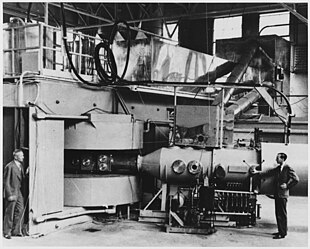A cyclotron is a type of particle accelerator invented by Ernest O. Lawrence in 1929-1930 at the University of California, Berkeley, and patented in 1932. A cyclotron accelerates charged particles outwards from the center along a spiral path. The particles are held to a spiral trajectory by a static magnetic field and accelerated by a rapidly varying (radio frequency) electric field. Ernest O. Lawrence was awarded the 1939 Nobel prize in physicsfor this invention.
Cyclotrons were the most powerful particle accelerator technology until the 1950s when they were superseded by the synchrotron, and are still used to produce particle beams in physics and nuclear medicine. The largest single-magnet cyclotron was the 4.67 m (184 in) synchrocyclotron built between 1940 and 1946 by Lawrence at the University of California at Berkeley, which could accelerate protons to 730 million electron volts (MeV). The largest cyclotron is the 17.1 m (56 ft) multimagnet TRIUMF accelerator at the University of British Columbia in Vancouver, British Columbia which can produce 500 MeV protons.
Over 1200 cyclotrons are used in nuclear medicine worldwide for the production of radionuclides.

